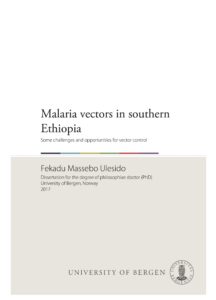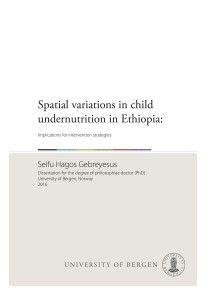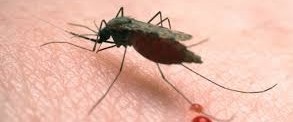I have recently updated our malaria research web site; please see http://malaria.w.uib.no
Category Archives: Research Training
Entomological evaluation of vector control
Kena, O. 2017. Entomological impact of combined and separate use of indoor residual spraying and long-lasting insecticidal nets for malaria prevention in Adami Tullu district, South-Central Ethiopia. PhD thesis. Addis Ababa University.
Indoor residual spraying (IRS) and long-lasting insecticidal nets (LLINs) are the key frontline malaria prevention interventions in Ethiopia. Both target Anopheles arabiensis, the sole primary malaria vector. Universal coverage of both interventions has been promoted and there is a growing demand in combination of interventions for malaria control and elimination. However, available evidence is contradictory wether the combined intervention is better than either IRS or LLINs alone. To investigate whether IRS and LLINs combination provides added protective impact on An. arabiensis compared to either IRS or LLINs alone, a cluster randomized controlled trial was carried out in Adami Tullu district, south-central Ethiopia. Villages were randomly allocated to four study arms: IRS+LLINs, IRS, LLINs, and control. All households in the IRS+LLINs and LLINs arms were provided with LLINs (PermaNet 2.0) free of charge. Households in the IRS+LLINs and IRS arms were applied with propoxur before the main malaria transmission season in 2014 and 2015. Adult mosquitoes were collected in randomly selected villages in each arm using CDC light trap catch (LTC) set close to a sleeping person, pyrethrum spray catch (PSC), and artificial pit shelter (PIT), for measuring host-seeking density (HSD), indoor resting density (IRD), and outdoor resting density (ORD) of the anophelines. Human landing catch (HLC) was performed in selected villages to monitor the impact of the interventions on local mosquito biting behaviours (biting location, time and host preference).
Collected anophelines were identified to species by use of standard morphological keys and additional use of molecular methods to separate sibling species of the An. gambiae complex. Enzyme-linked immunosorbent assay (ELISA) was used to detect malaria infections in mosquitoes and the sources of mosquito blood meals. Mean densities were compared using incidence rate ratio (IRR) calculated by negative binomial regression. Parity rate (percentage of parous females) was also determined by ovarial dissection. Human blood index (HBI) was expressed as the proportion of mosquitoes with human blood divided by the total number of blood-fed mosquitoes tested.
A total of 1786 female anophelines of four species (An. arabiensis, An. pharoensis, An. ziemanni and An. funestus s.l.) were collected over two transmission seasons during the intervention period (2014-2015). Anopheles numbers were highest in the control arm (41.3% of total) followed by LLINs (25.4%), IRS (18.0%), and IRS+LLINs (15.8%). In most of the vector parameters estimated, the impact of IRS and LLINs combined and separate interventions were significantly higher in communities that recieved the interventions (in experimental groups) compared with untreated communities (control group). The mean HSD of An. arabiensis in the IRS+LLINs arm was similar to the IRS arm (0.03 vs. 0.03/ house/LTC/night) but lower than the LLINs arm (0.03 vs. 0.10/house/LTC/night, p=0.07) and so was the difference in IRD and ORD between the IRS+LLINs compared to the IRS arm. However, both IRD and ORD of An. arabiensis were higher in LLINs compared to IRS+LLINs (p < 0.001 for indoors). Parity rate of An. arabiensis were similar among the intervention arms. None of the 1786 samples of four species tested by ELISA was positive for P. falciparum and P. vivax CSP infection in all of the study arms. Anopheles arabiensis preferred mainly bovine and human hosts for blood meal sources with high HBI in the LLIN alone. Indoor resting habit of An. arabiensis was less impacted by LLINs alone intervention compared to IRS + LLINs or IRS alone.
In conclusion, the IRS+LLINs and the IRS alone each was similarly most effective against An. arabiensis as compared to the LLINs alone. The IRS+LLINs provided added impact on An. arabiensis compared to LLINs alone. The LLINs alone had poor impact on densities and human biting rates of An. arabiensis in this study setting.
You can download the thesis here: Oljira-Kenea-thesis
South Ethiopia Network of Universities in Public Health (SENUPH)
We have recently updated the web page for the South Ethiopia Network of Universities in Public Health (SENUPH); please see https://senuph.w.uib.no .
The website includes information about the program, and also about the research work done by each of the PhD students.
PhD in malaria entomology, and first and second opponents from Africa
 On Friday, January 27, Fekadu Massebo defended his PhD thesis at the University of Bergen. This was a good defence with a thorough scientific discussion. For the first time at the University of Bergen, the first and second opponents were African. This is a testimony to the emerging strength of African scientists.
On Friday, January 27, Fekadu Massebo defended his PhD thesis at the University of Bergen. This was a good defence with a thorough scientific discussion. For the first time at the University of Bergen, the first and second opponents were African. This is a testimony to the emerging strength of African scientists.
The picture shows the candidate after the defence, the opponents, and the supervisors. From left: Professor Sven Gudmund Hinderaker (Acting Dean), Fekadu Massebo, Dr Silas Majambere (First opponent), Professor Tehmina Mustafa from UiB, Professor Bernt Lindtjørn (supervisor), Dr Tarekegn Abeku (Second opponent) and Ass Professor Meshesha Balkew (supervisor) from Addis Ababa University.
New PhD: Malaria vectors in southern Ethiopia
 Massebo F. Malaria vectors in southern Ethiopia. Some challenges and opportunities for vector control. PhD. University of Bergen, 2017. Bergen
Massebo F. Malaria vectors in southern Ethiopia. Some challenges and opportunities for vector control. PhD. University of Bergen, 2017. Bergen
Background: Malaria is a public health problem in Ethiopia, where more than 60% of the population lives in risky areas. Since 2005, malaria-related sicknesses and deaths have substantially decreased in the country, mainly due to the increasing coverage of vector control interventions and chemotherapy. On the other hand, resistance to most public health insecticides is widely spreading among the populations of the principal malaria vector Anopheles arabiensis. Therefore, assessing the susceptibility status of local malaria vectors is an essential activity to improve the effectiveness of the interventions, by introducing the appropriate insecticide resistance management strategies. There are also substantial gaps in knowledge regarding the entomological inoculation rate (EIR), which is an indicator of the intensity of malaria transmission, and are used to assess the impact of vector control interventions. Understanding the species composition, feeding and resting behaviours, parity rate, as well as human biting and sporozoite rates, are all important in evaluating the effectiveness of interventions and planning for supplementary vector control tools. Moreover, improving housing, such as screen doors and windows, and closing openings on walls and eaves, might reduce the entry of malaria vectors and provide protection from infectious bites of malaria vectors.
Objective: The study was carried out to help assess the species composition, age structure, feeding patterns, sporozoite infection rate, entomological inoculation rate and insecticide susceptibility status of An. arabiensis, and evaluate the impact of screened houses on its indoor density.
Methods: The study was done in the Chano Mille Kebele in southwestern Ethiopia. The longitudinal entomological study was conducted from May 2009-April 2010, whereas the house screening intervention was done between April-November 2011. Thirty houses (10 houses for each collection method) were randomly selected for biweekly Anopheles mosquito sampling. The Anopheles mosquitoes were collected by the Centers for Disease Control and Prevention (CDC) light traps, pyrethrum spray catches (PSC) and from artificial pit shelters by aspirating. Enzyme-linked-immunosorbent assay (ELISA) was used to analyse the blood meal origins and circumsporozoite proteins. The EIR of P. falciparum and P. vivax of An. arabiensis was calculated by multiplying the sporozoite and human biting rates from CDC light traps and PSC collections.
A randomized control trial was conducted to assess the impact of screening windows and doors with wire mesh, and closing openings on eaves and walls by mud on the indoor density of An. arabiensis. Baseline mosquito data was gathered biweekly from 40 houses by CDC light traps in March and April 2011 to randomize houses into both control and intervention groups. The windows and doors of 20 houses were screened by mosquito-proof wire mesh, and openings on the walls and eaves were closed by mud. The rest of the 20 houses were assigned to the control group. Mosquitoes were collected biweekly in October and November 2011 from both the control and intervention houses.
Results: Anopheles species, comprised of An. arabiensis, An. marshalli, An. garnhami, An. funestus group, An. pharoensis, An. tenebrosus, An. rhodensiensis, An. flavicosta, An. longipalpis, An. daniculicus, An. pretoriensis, An. chrysti, An. moucheti, An. distinctus and An. zeimanni, were documented in the area. Anopheles arabiensis was by far the most dominant species.
The overall human blood index (HBI) of An. arabiensis, including the mixed blood meals, was 44%, whereas the bovine blood index (BBI), including mixed blood meals, was 69%. The majority of An. arabiensis (65%) from the indoor-resting collection had bovine blood meal, which was unexpected. The higher proportion (75%) of indoor host-seeking An. arabiensis collected by CDC light traps had contact with humans. Only 13% An. arabiensis from pit shelters had human blood meal, while 68% had bovine blood meal. Anopheles arabiensis showed a consistently higher feeding pattern on cattle than on humans, regardless of collection sites and the high number of the human population. The human and bovine feeding patterns of An. arabiensis showed little change due to the number of cattle to human ratio of each household. Anopheles marshalli and An. garnhami showed similar feeding patterns.
Anopheles arabiensis was highly resistant to four pyrethroid insecticides tested (lambdacyhalothrin, cyfluthrin, alphacypermethrin and deltamethrin) and DDT, with a maximum mortality rate of 56% due to lambdacyhalothrin and a minimum of 10% due to DDT.
The circumsporozoite protein ELISA test revealed 11 P. falciparum infections out of 14 sporozoite positive An. arabiensis (the other three were P. vivax), thereby confirming that this species is the principal vector of P. falciparum and P. vivax parasites. The P. falciparum sporozoite rate of An. arabiensis was 0.32% for CDC light traps, 0.28% for pit shelters and 0.23% for PSCs. The overall estimated annual P. falciparum EIR of An. arabiensis from CDC light traps was 17.1 infectious bites/person/year (ib/p/y), but it varied between houses, from a 0 EIR in 60% of houses to 73.2 in a house close to the major breeding site. Hence, those houses nearest to the mosquito breeding sites had a higher risk of exposure to infectious bites. The P. falciparum EIR of An. arabiensis was 2.4 in the dry season and 14.7 in the wet season, indicating 6.1-fold more infectious bites in the wet- than in the dry season. The P. falciparum and P. vivax EIR of An. arabiensis from PSC was 0.1ib/p/y, while the P. vivax EIR of An. arabiensis from CDC light traps was 2.41ib/p/y.
The screening of doors and windows with wire mesh, and closing the openings on eaves and walls by mud, significantly reduced the indoor density of host-seeking An. arabiensis by 40%. The intervention was cheap, and can be incorporated into malaria vector control programmes by local communities.
Conclusion: Anopheles arabiensis showed a consistently higher feeding pattern on cattle than on humans regardless of collection sites and the high number of human population. It was the most abundant and the principal vector of P. falciparum and P. vivax, while An. marshalli and An. garnhami were the second and third most abundant species, but neither of them was positive for CSPs. The transmission of malaria is heterogeneous; those houses nearest to the mosquito breeding sites (hot spots) had a higher risk of exposure to the infectious bites of An. arabiensis. Anopheles arabiensis was resistant to pyrethroid insecticides, the only class of insecticides recommended for LLINs treatment; as a result, there should be an action programme to manage insecticide resistance. Finally, supplementary methods of vector control, such as the screening of houses, could be included to help improve malaria control in the area based on the principle of integrated vector management.
Presentation at 65th Annual meeting of the American Society of Tropical Medicine and Hygiene
Impact of combining Indoor Residual Spraying and Long-Lasting Insecticidal Nets on Anopheles arabiensis in Ethiopia: Preliminary findings of a randomized controlled trial
Oljira Kenea, Meshesha Balkew, Habte Tekie, Teshome Gebre-Michael, Wakgari Deressa, Eskindir Loha, Hans J. Overgaard, Bernt Lindtjørn
Abstract
The current malaria vector control interventions, indoor residual spraying (IRS) and long-lasting insecticidal nets (LLINs) have been used in combination in sub-Saharan Africa with inconclusive evidence that the combined intervention is more effective than either IRS or LLINs alone. In Ethiopia, both interventions target Anopheles arabiensis, the sole primary malaria vector. This study compared the impact of combining IRS and LLINs with either intervention alone in south-central Ethiopia. Villages were randomly allocated to four study arms: IRS + LLIN, IRS, LLIN, and control. LLINs (PermaNet 2.0) were provided free of charge. IRS with propoxur was applied before the main malaria transmission season in 2014 and 2015. Adult mosquitoes were collected in randomly selected villages in each arm using CDC light trap catch (LTC) set close to a sleeping person, pyrethrum spray catch (PSC), and artificial pit shelter (PIT), for measuring host-seeking density (HSD), indoor resting density (IRD), and outdoor resting density (ORD). Human landing catch (HLC) was performed in selected villages to monitor An. arabiensis biting behaviors. Mean densities were compared using incidence rate ratio (IRR) calculated by negative binomial regression. A total of 1786 female anophelines of four species was collected of which An. arabiensis (n=574) was highest in the control arm (51.4%) followed by LLIN (31.5%), IRS (9.2%), and IRS+LLIN (7.9%). The mean HSD of An. arabiensis in the IRS+LLIN arm was similar to either the IRS arm (0.03 vs. 0.03/ house/LTC/night) or the LLIN arm (0.03 vs. 0.10/house/LTC/night, p=0.07) and so was the difference in IRD and ORD between the IRS and LLIN compared to the IRS arm. However, both IRD and ORD were higher in LLIN compared to IRS+LLIN (p < 0.001 for indoors). In all study arms, An. arabiensis was actively biting indoors and outdoors throughout the night with an early night biting peak before the local people retire to bed. IRS+LLIN compared to IRS had equal powerful impact on resting density of An. arabiensis, but LLIN had the least impact.
New information about malnutrition in Ethiopia
 New PhD: On September 16, Seifu Hagos Gebreyesus from Ethiopia, shall defend his PhD work at the University of Bergen:
New PhD: On September 16, Seifu Hagos Gebreyesus from Ethiopia, shall defend his PhD work at the University of Bergen:
Spatial variations in child undernutrition in Ethiopia: Implications for intervention strategies
Summary
Background: Ethiopia is one of the countries with the highest burden of undernutrition, with rates of stunting and underweight as high as 40% and 25%, respectively. National efforts are underway for an accelerated reduction of undernutrition by the year 2030. However, for this to occur, understanding the spatial variations in the distribution of undernutrition on a varying geographic scale, and its determinants will contribute a quite a bit to enhance planning and implementing nutrition intervention programmes.
Objectives: The aim of this thesis was to evaluate the large- and small-scale spatial variations in the distribution of undernutrition indicators, the underlying processes and the factors responsible for the observed spatial variations.
Methods: We used nationally available climate and undernutrition data to evaluate the macro-scale spatial pattern of undernutrition and its determinants. We applied a panel study design, and evaluated the effect of growing seasonal rainfall and temperature variability on the macro-scale spatial variations (Paper I). We conducted a repeated cross- sectional survey to assess the performance of the Household Food Insecurity Access Scale (HFIAS) developed internationally to measure household food insecurity. The results from this validation work were used to modify the HFIAS items for subsequent papers (Papers III and IV). We conducted a census on six randomly selected kebeles to evaluate the spatial patterns of undernutrition on a smaller scale (Paper III). For Paper IV, we conducted a cross-sectional survey on a representative sample, and employed a Bayesian geo-statistical model to help identify the risk factors for stunting, thereby accounting for the spatial structure (spatial dependency) of the data.
Results: In Paper I, we demonstrated spatial variations in the distribution of stunting across administrative zones in the country, which could be explained in part by rainfall. However, the models poorly explained the variation in stunting within an administrative zone during the study period. We indicated that a single model for all agro-ecologic zones may not be appropriate. In Paper II, we showed that the internal consistency of the HFIAS’ tools, as measured by Cronbach’s alpha, was adequate. We observed a lack of reproducibility in HFIAS score among rural households. Therefore, we modified the HFAIS tool, and used it for subsequent surveys in this thesis (Papers III and IV). In Paper III, spatial clustering on a smaller scale (within a kebele) was found for wasting and severe wasting. Spatial clustering on a higher scale (inter-kebele) was found for stunting and severe stunting. Children found within the identified cluster were 1.5 times more at risk of stunting, and nearly five times more at risk of wasting, than children residing outside this cluster. In Paper IV, we found a significant spatial heterogeneity in the distribution of stunting in the district. Using both the local Anselin Moran’s I (LISA) and the scan statistics, we identified statistically significant clusters of high value (hotspots) and a most likely significant cluster for stunting in the eastern part of the district. We found that the risk of stunting was higher among boys, children whose mother or guardian had no education and children who lived in a food-insecure household. We showed that including a spatial component (spatial structure of the data) into the Bayesian model improved the model fit compared with the model without this spatial component.
Conclusion: We demonstrated that stunting and wasting exhibited a spatial heterogeneity, both on a large and small scale, rather than being distributed randomly. We demonstrated that there is a tendency for undernourished cases (stunting and wasting) to occur near each other than to occur homogeneously. We demonstrated a micro-level spatial variation in risk and vulnerability to undernutrition in a district with a high burden of undernutrition. Identifying such areas where a population at risk lives is central in assisting a geographical targeting of intervention. We recommend further study, possibly using a trial design or implementation research approach, to help evaluate the feasibility and benefits of geographically targeting nutritional interventions.
The thesis can be downloaded here.
Joint PhD Programme
Joint-PhDs are doctorates, which are done at two degree-awarding institutions. This doctorate means that you are fully registered in two universities, having to comply with admission requirements, and assessment regulations at both institutions, and it will result in one jointly awarded PhD (one diploma with the two university logos).
The other benefits for students are:
- Access to complementary facilities and resources
- Exposure to two cultural approaches to research
- International student mobility
- Enhanced acquisition of research and transferable skills, such as negotiation skills, use of videoconferencing, adaptability…
- Better networking opportunities
Recently, Hawassa University and the University of Bergen agreed on such a joint PhD degree.
This programme is funded by The South Ethiopia Network of Universities in Public Health (SENUPH), and nine PhD students have been registered at the home institution which in this case is Hawassa University. The currently available financial support is for staff at Hawassa, Dilla and Wolaita Sodo universities. We plan to admit seven more students (four women and three men) in September 2016.
You can get more information about the admission requirements and about topics that this programme will prioritise by writing to Dr Eskindir Loha or to Professor Bernt Lindtjørn.
The structure of the joint PhD programme can be downloaded here.
South Ethiopia Network of Universities in Public Health
The Norwegian Programme for Capacity Development in Higher Education and Research for Development (NORHED) recently told us that we have been awarded the project: South Ethiopia Network of Universities in Public Health (SENUPH): improving women’s participation in post-graduate education.
The vision of this project is to enhance the capacity of universities in south Ethiopia to train sufficient staff for the Region to carry out essential public health work, and do essential research to improve the health of the people living in South Ethiopia. This will be carried out by:
- Establishing, and strengthening a network of the main universities in south Ethiopia doing teaching so the universities can increase their teaching capacity and train enough staff to meet the demands within the public health sector.
- Substantially increasing the number of women with postgraduate education
- Increasing the number of teachers at the universities in public health.
- Strengthening the research capacity through PhD and Master’s programme so the research done in the region will aid in defining the future health policy.
This project has four integrated parts:
- A PhD programme for all universities and located at Hawassa University
- A master programme in Maternal and Reproductive health at Dilla University
- A master programme in Nutrition at Wolaita Soddo University and
- A master programme in medical entomology (malaria control) at Arba Minch University).
By developing a network of the main universities in south Ethiopia we will address several important areas such as staff development, and enhance the human capacity in higher education, in public health, reproductive health, and nutrition and malaria control.
The Southern Nations, Nationalities and Peoples Region in Ethiopia has a population of about 16 million people, representing more than 50 ethnic groups that live in a variety of geographic and socioeconomic areas. The area is typical of Ethiopia with high population densities, high fertility and child mortality rates, and high maternal death rates.

